All areas of social life are permeated by digitalization. With its increase, originally insignificant side effects also become a challenge. For example, we must increasingly ask ourselves what ecological and climatic consequential costs they entail and how we can counteract this. The ideal of a clean and green economy through digitalization is opposed by the fact that this technology has now a noticeable share of CO2 emitted worldwide. According to the SHIFT Project, this share is now well over 4% of global greenhouse gas emissions.
It cannot be ruled out that digitalization will become one of the world’s largest emitters of greenhouse gases and thus one of the largest global climate problems.
Nevertheless, digitalization can hardly be dispensed with. Achieving the Sustainable Development Goals of the 2030 Agenda is dependent on them and the renunciation of them would result in even higher emissions of greenhouse gases. After all, it is the intelligent digital solutions without which increasingly complex processes in the economy and society can hardly be controlled – also with regards to resource consumption, sustainability and efficiency.
Efficient hardware
So we need more digitalization with significantly lower CO2 consumption. For some time now, the focus has been on the resource consumption of devices and networks. Efforts to reduce this have led to interesting and forward-looking projects at all levels of digitalization.
From the Fairphone, a smartphone that also pays attention to easy repairability and replaceability of its components, computers that automatically turn themselves off when not in use, up to data centers in the sea.
Many of these projects have in common that they primarily focus on the efficiency of hardware. Cable lengths and running times are shortened, machines are moved to places that allow significantly more advantageous resource efficiency and are designed for a more sustainable and longer use.
Efficient software
So far, less of a focus of interest has been the possibility of making software more efficient. Because often the use of more complex algorithms also means a higher energy consumption, although this is partly unnecessary. Often, small losses in accuracy, throughput or runtime are justifiable if they provide sufficient benefits in terms of energy consumption.
The Hasso Plattner Institute Potsdam has therefore developed its own approach, Clean IT, which follows a new paradigm: Sustainability by Design. In this paradigm, it is important to consider the digital carbon footprint already in the system design.
The parameter of energy efficiency must be balanced with the other system parameters: runtime, accuracy and data throughput. If, for example, a significant reduction in runtime can be achieved by slightly reducing the accuracy of an algorithm, this means an increase in efficiency, provided that the result is within the tolerance range of the task. Such a kind of increase in efficiency is already practically possible today, as HPI has shown in its own projects.
Examples of Clean-IT
Summary
Digitalization is an important part of our future, but a part with significant energy requirements that need to be minimized. This is also necessary to achieve many SDGs. Increasing efficiency is possible on the one hand by sustainable production and mindful use and application of ICT technology.
In addition, however, the optimization of software and algorithms through sustainability by design represents an interesting approach that has not been the focus of interest so far. In this way, the carbon footprint of software can be taken into account right from the start and in some cases lead to considerable increase in efficiency.



